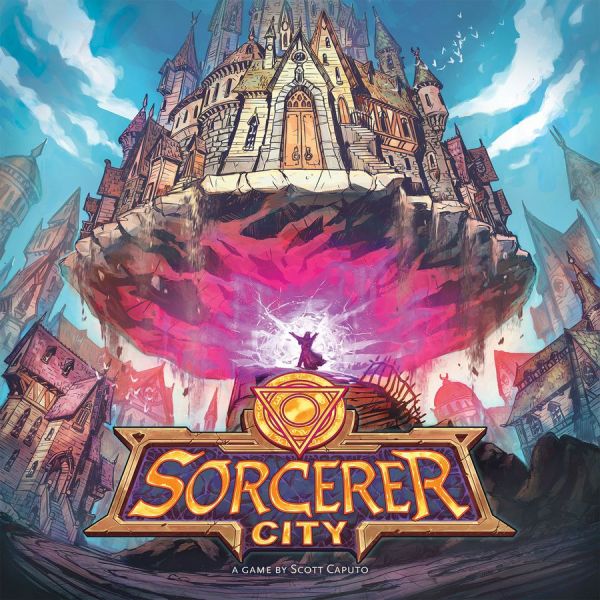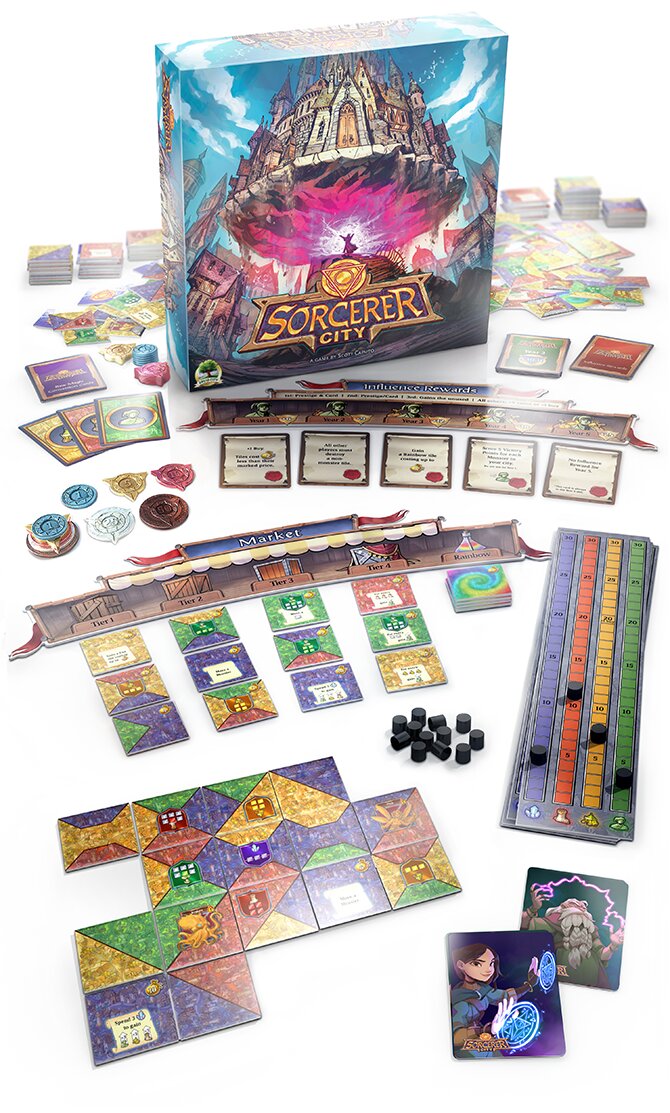Be the Quickest and Wisest Wizard Architect in Sorcerer City

The latest from Scott Caputo is a real-time tile placement game where players are challenged with meeting goals by crafting their own colorful cities.
Gameplay
Sorcerer City is a 1-6 player game where players are tasked with building and rebuilding their own cities to ever-changing specifications. The game setup begins by placing out the market and supplying it with the appropriate tiles, numbered on the back to match each vendor listed on the market. Likewise, set up the influence rewards board and populate each yearly space with an influence card from the shuffled deck, setting the special Year 5 card in the appropriate space. Place a tier 1 monster card and their appropriate tiles below the influence cards for years 1 and 2 and a tier 2 monster card and tiles under years 3 and 4. Hand each player a starting deck of tiles (each will have a specific symbol on the back of the tiles), three magic transformation cards and an individual progress track.
The goal of Sorcerer City is to create individual cities that meet the criteria of the goals on some of the tiles to gain money, raw magic, influence and prestige. Raw magic allows players to use their magic transformation cards to gain more of the other three categories during the scoring phase. Money allows players to buy tiles from the marketplace. Influence determines the order in which players get to buy tiles from the marketplace. Prestige equals victory points, which determine the game’s winner at the game’s five rounds (years) have ended.
Tiles have different colors and goals on each tile front. Goals are denoted by shields and will show players specific goals they can work toward that will offer bonuses on one of the four categories on the progress track. These goals include specific layouts of colors within the tiles as they place them, and each successful tile part of meeting the goal will count as one point into that category on the progress track during scoring.
Play begins when someone flips over the sand timer. In real-time, players begin to lay out their cities by taking the top tile from their deck, placing it however they wish in front of them, and then taking out the next tile and placing it adjacent (this does not include diagonally) to an existing tile in their city. Once a player is done placing a tile the way they wish, they may not move or adjust it again. Players have approximately two minutes of time to set up their city as they see fit, working to meet any criteria on goal tiles.
When the timer ends, players will score their goals and then note each other’s influence. The player with the most influence will claim the rewards on the influence rewards board for the corresponding year. The player with the second-most influence would get the second place rewards, and so forth in descending order. The influence board helps guide players to what they receive or choose depending on their influence ranking for each round. Influence also determines the order in which players can purchase tiles from the marketplace. Once a tile has been bought, then it is replaced and the next player resolves their marketplace purchase(s). There are rewards and progress track thresholds that may allow players to buy more than one tile in the marketplace.
Players note their prestige and gain prestige tokens equaling that number. Finally, the monster tiles for the year are given to each player and everyone resets their progress board to zero across all categories. Players shuffle their tile decks to mix in any new marketplace tiles and monsters and play begins again. After five rounds of play, the player with the highest prestige at the end of the game is the winner.

Review
With a real-time spatial puzzle to decipher, Sorcerer City may cause some eyes to roll into the backs of skulls as players try to figure out how to maximize their cities and score as many goals as possible. There’s also a learning curve for first time players as they not only navigate goals on the tiles, but try to think about their progress track as well as including and accommodating monsters, making sure tiles are placed adjacently, and doing this all in two minutes.
However, not dissimilar to Nine Tiles Panic, this is part of the fun of Sorcerer City. And if it’s too challenging at first, Scott Caputo has variants that allow players to experiment with set-up gameplay without compromising the core gameplay. These variants, which also include artifact tiles for advanced players, keep Sorcerer City exciting and provide flexibility and longevity into a familiar game mechanic.
Beyond the gameplay, Sorcerer City presents a lot of game in a well-organized box that makes setup and tear down easy and elegant. Likewise, despite having plenty of rules and variants, the rulebook is easy to read and provides a robust appendix to allow players to be prepared when buying tiles, resolving actions, and pre-planning during both the building and marketing phases.
Sorcerer City isn’t completely perfect, however. Players are going to get tripped up on adjacency versus neighboring when it comes to laying tiles and goal resolution, and though the rulebook explains this concisely and easily, players who are already frazzled by a game that is a timed spatial puzzle that rewards efficiency and a basic understanding of tile/deck building ideas, it can be difficult to remember which is which in the heat of two heart-pounding minutes of tile-laying competition.
These problems are few, which is why Sorcerer City is a great game that adds some depth to what is essentially a light game that can be played casually or competitively depending on the group and mood.
Pros: Familiar mechanics presented in a fun mashup, plenty of variants to make each game different and special
Cons: Real-time spatial puzzle game that may make people too nervous or too competitive in the wrong gaming groups




